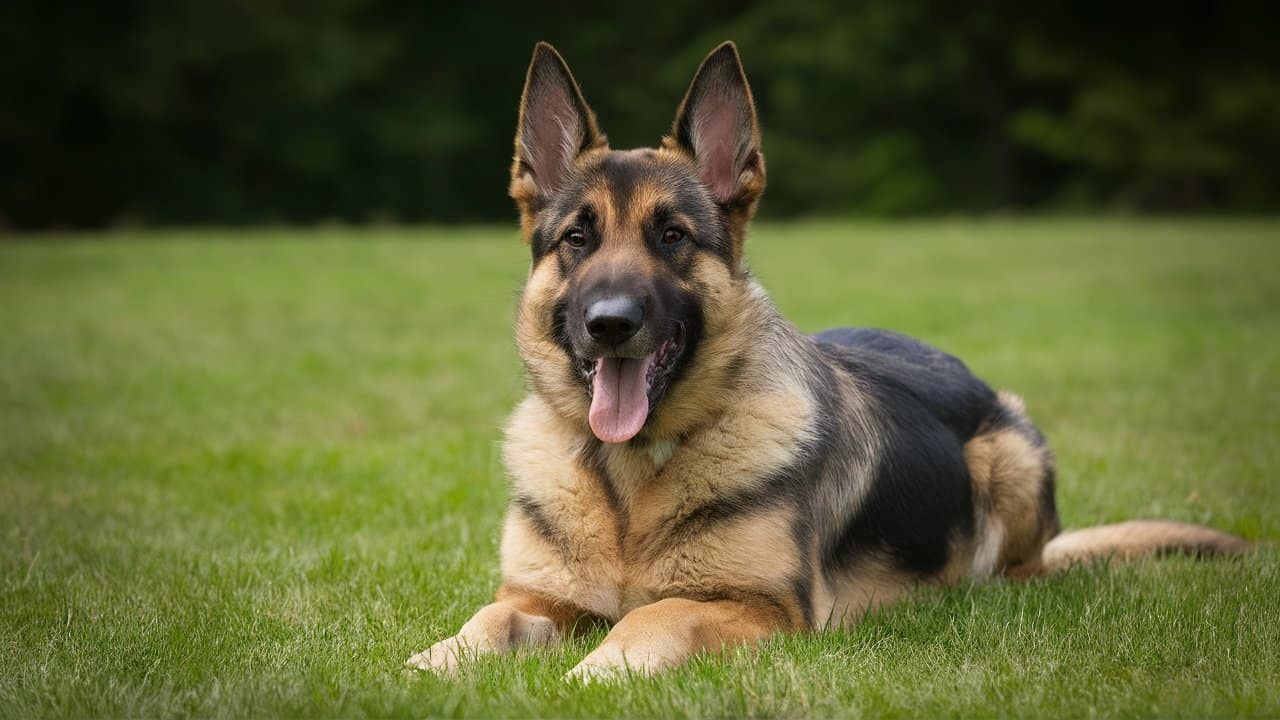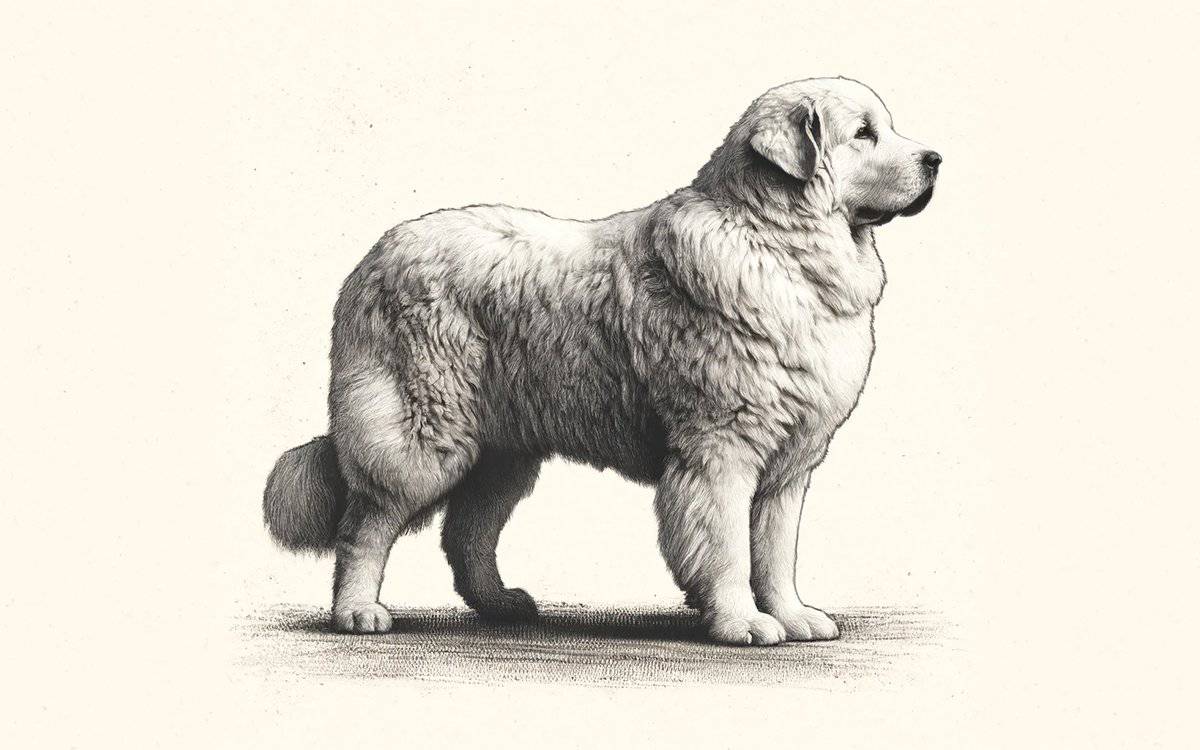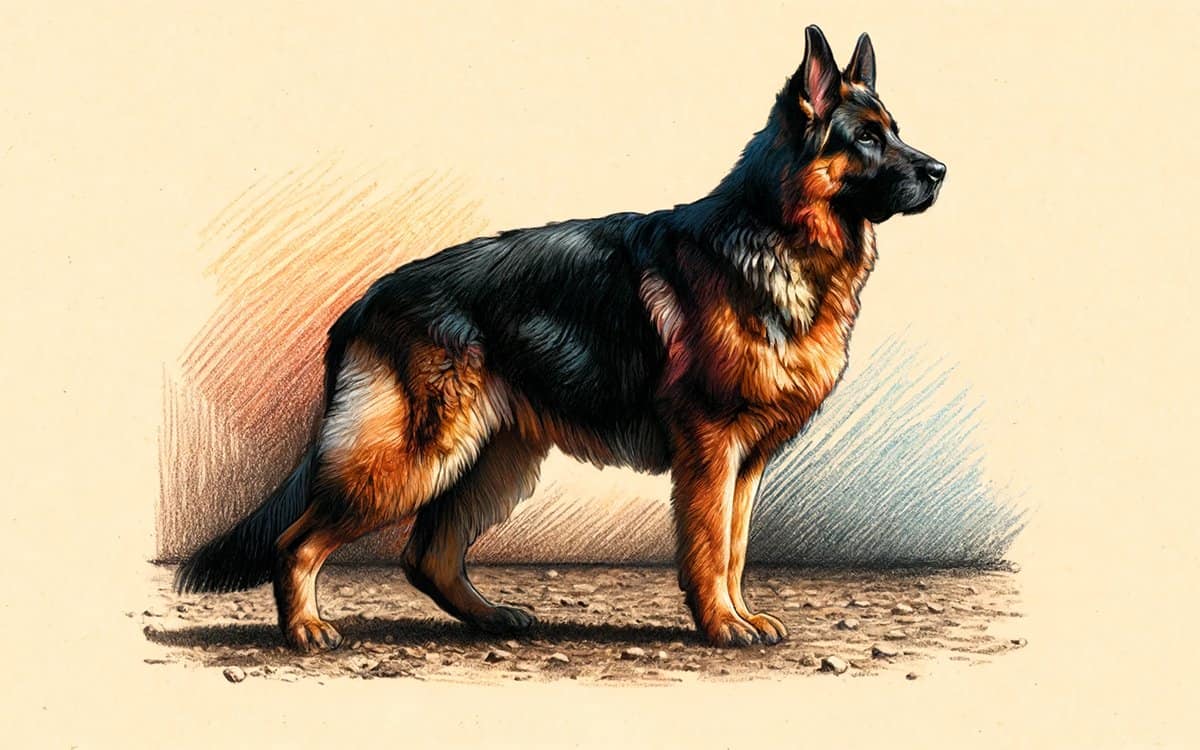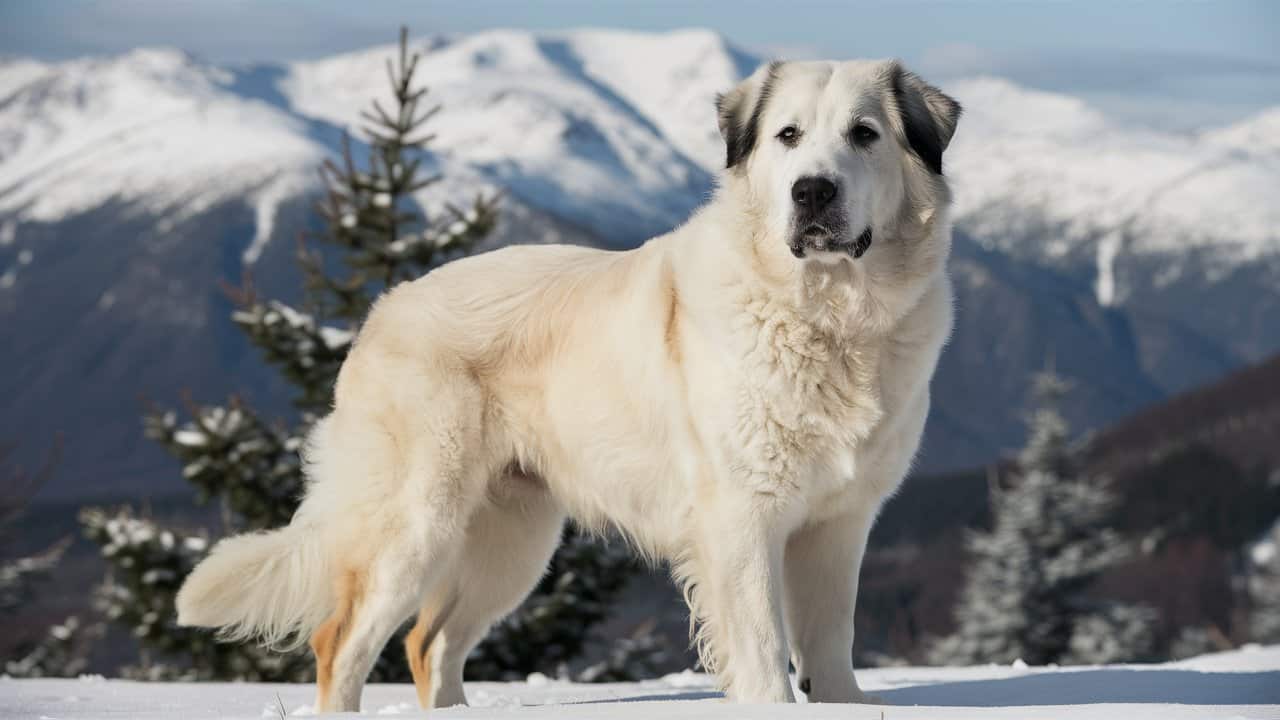The Great Pyrenees is a gentle giant, known for its calm demeanor and fluffy white coat. It excels in guarding livestock but also adapts well to family life.
Its large size and thick fur are perfect for colder climates. This breed needs space to roam and prefers a quiet environment.
German Shepherds, on the other hand, are versatile working dogs with a reputation for intelligence and agility. Their tan-and-black coats are unmistakable.
They serve in various roles, from police work to assistance for people with disabilities. These dogs crave activity and mental challenges, making them great for active families.
Table of Contents
Visual Differences of Great Pyrenees and German Shepherd
Great Pyrenees dogs are really big, bigger than German Shepherds. They have thick, fluffy fur that can be white or tan and makes them look even bigger.
German Shepherds are strong too, but they’re more muscular and come in different colors like black and tan, or all black.
Great Pyrenees have floppy ears that make them look nice and calm, while German Shepherds have pointy ears that make them look like they’re always ready to go.
A Quick Overview – Great Pyrenees vs German Shepherd
Great Pyrenees | German Shepherd |
Height 25-32 (63.5-81.3cm) | Height 22-26 inches (55.9-66cm) |
Weight 85-160 lbs (38.6-72.6kg) | Weight 50-90 lbs (22.7-40.8kg) |
Coat Thick double coat, weather-resistant | Coat Dense, straight, short (or long) |
Temperament Patient, confident, gentle | Temperament Intelligent, confident, courageous |
Trainability Independent, can be stubborn | Trainability Highly trainable, eager to please |
Lifespan 10-12 years | Lifespan 7-10 years |
Health Concerns Bone cancer, hip dysplasia, bloat | Health Concerns Hip dysplasia, elbow dysplasia, bloat |
Family-friendly Yes, good with children and other pets | Family-friendly Yes, but can be aloof with strangers |
Exercise Needs Moderate; needs regular walks | Exercise Needs |
Breed History of Great Pyrenees and German Shepherd

The Great Pyrenees has a noble lineage, tracing back to the Pyrenees Mountains. They stood watch over flocks, deterring predators. This breed was cherished for its bravery and strength in guarding livestock.
German Shepherds emerged from Germany, bred primarily for herding. Their intelligence quickly made them ideal for police and military roles. These dogs became synonymous with protection and loyalty.
Both breeds have evolved into beloved family pets. Their protective instincts make them loyal companions. They fit well in homes due to their loving nature.
Appearance of Great Pyrenees and German Shepherd
The Great Pyrenees boasts a large and powerful frame, making it an impressive sight. Its coat is thick and fluffy, designed to protect against harsh weather.
This breed’s size can be a factor in the choice of pet for those living in smaller spaces, like apartments. They need room to move and may not fit well in compact living conditions.

In contrast, the German Shepherd displays an athletic build, reflecting its role as a working dog. It’s built for action, with a body that shows off its agility and endurance. This breed is often the first pick for people who want an active companion.

Their facial expressions are telling. The Great Pyrenees has a soft, gentle look that reflects its calm nature. It stands in stark comparison to the German Shepherd’s face, which always seems focused and alert.
This difference is important when you’re on the search for a new furry friend. It tells you much about their personalities before you even make contact.
Coat & Colors

The Great Pyrenees boasts a long, thick coat perfect for cold weather. Its fur is mostly white, sometimes with gray or tan markings. This breed requires regular brushing to prevent mats and tangles. The grooming routine helps manage shedding and keeps the coat clean.
German Shepherds have a shorter, denser coat that also needs care. They come in colors like black and tan, sable, or all black. Regular grooming is essential to minimize shedding and maintain a healthy skin and coat.
Both breeds shed throughout the year. Owners should brush them several times a week. During shedding seasons, daily brushing might be necessary to control the amount of loose hair.
Temperament
The Great Pyrenees shows a patient and affectionate side, often seen as a gentle giant. They are known for their calm demeanor. In contrast, the German Shepherd displays intense loyalty and is highly protective of their family. Both dogs have strong temperaments but show it in different ways.
Socialization plays a key role in shaping these breeds. It helps them behave well around kids and other pets. The Great Pyrenees may be independent, but they still love being part of the family. The German Shepherd thrives on being busy and loves to learn new things to stay sharp.
They differ in how they handle weather changes too. The thick coat of the Great Pyrenees means they can tolerate cold temperatures well. German Shepherds adapt to various climates but might prefer cooler weather due to their dense fur.
Great Pyrenees need space to roam and be independent, while German Shepherds need tasks to keep their minds active. Without mental challenges, German Shepherds may get bored and cause trouble.
Trainability
Great Pyrenees dogs are known for their independent streak. This trait can make them less responsive to traditional obedience training.
They think for themselves and may not always follow commands right away. Owners need patience and consistency when training these gentle giants.
It’s important to start early and use positive methods.
German Shepherds, on the other hand, show a strong eagerness to learn. Their desire to please their owners makes them highly trainable.
With proper guidance, they quickly pick up new commands. These intelligent dogs thrive on mental challenges and enjoy learning new tasks.
Both breeds benefit greatly from early socialization. Meeting different people and animals helps them become well-adjusted adults.
Positive reinforcement is key; it builds trust and encourages good behavior. Treats, praise, and playtime work better than harsh words or actions.
Exercise
Great Pyrenees thrive with regular moderate exercise. They need it to stay happy and healthy. Long walks keep their minds and bodies active. Without this, they may get bored. Boredom can lead to naughty behavior.
German Shepherds have lots of energy. They need vigorous daily activity to feel good. Activities like running and agility training work well for them. These exercises use their high intelligence and energy in the best way.
For Great Pyrenees, leisurely strolls are perfect. They enjoy taking their time outdoors. Sometimes, they can even pull small carts if trained properly. This gives them a sense of job and order.
German Shepherds excel in more challenging tasks. They love learning new things during training sessions. Games that test their smarts are great too. This breed needs space to run and play.
Both breeds benefit from having a routine. It helps them know what to expect each day. But remember, they need different amounts of exercise and types of activities.
Grooming
The Great Pyrenees boasts a thick, fluffy coat that requires much care. They need regular brushing, several times a week, to keep their fur mat-free and shiny.
Occasional baths are essential too, but not too often, as it can strip their coat of natural oils. Their grooming is a commitment but keeps them looking majestic.
German Shepherds have a less demanding grooming routine. Their shorter coat still sheds, so regular brushing is key. It helps remove loose hair and keeps their coat healthy.
While they don’t need baths as often as the Great Pyrenees, keeping up with brushing is important for this active breed.
Both breeds need their nails trimmed regularly to avoid discomfort and potential health issues. Clean ears prevent infections, especially in German Shepherds with their upright ears.
Dental care is also critical; brushing teeth or using dental treats helps prevent gum disease. These practices ensure both breeds remain happy and healthy family members.
Feeding
Great Pyrenees dogs are known for their gentle nature and often work as livestock guardians. They need food that matches their size but also their lower energy levels.
These gentle giants do well on a diet that’s not too high in calories to avoid weight gain, especially since they’re less active than some other breeds.
Pet parents should give them enough food to support their large bodies, but not so much that they become overweight.
German Shepherds, on the other hand, are high-energy animals often used as working dogs or guard dogs. They require a balanced diet rich in protein to keep up with their active lifestyle.
Overfeeding can lead to obesity, which is harmful to their health and can shorten their lifespan. It’s important for pet owners to measure their German Shepherd’s food and provide regular exercise.
Both breeds benefit from a feeding schedule tailored to their needs. For Great Pyrenees, fewer calories are okay because of their low energy levels. German Shepherds may need more food spread out over the day to fuel their activities.
Consulting with a vet helps determine the right portion sizes and feeding times for each dog’s unique requirements.
Puppy Prices
When choosing a furry friend, the price of a puppy can be a big factor. Great Pyrenees puppies often have a price tag between $600 to $1500.
German Shepherds can range from $500 to $3000. Breeder reputation and bloodlines play a key role in these costs. High-quality lineage or award-winning parents can bump up the price.
After picking your pup, there’s more to consider than just the purchase cost. New owners should budget for initial veterinary care, which includes vaccinations, microchipping, and spay or neuter procedures.
Training classes are also wise investments for well-behaved companions. Don’t forget about supplies like beds, bowls, and toys.
It’s important to adopt from reputable breeders. They ensure puppies are healthy and well-socialized.
Alternatively, rescues offer loving dogs needing homes, often at lower costs. This choice supports animal welfare and can save on initial expenses.
Remember, dog ownership is more than upfront costs; it’s a long-term commitment of love and care.
Health Conditions and Concerns
Great Pyrenees dogs are known for their gentle nature and strength, but they face certain health issues.
Hip dysplasia is a common problem where the hip joint doesn’t fit together perfectly, which can cause pain and trouble moving. Bloat is another serious condition that can happen if their stomach fills with gas and twists.
Owners can help prevent these problems by keeping their dogs at a healthy weight and avoiding heavy exercise right after eating.
German Shepherds are smart and loyal but also have some health risks. Elbow dysplasia is similar to hip dysplasia but affects the elbow joints, leading to discomfort and limited movement.
Degenerative myelopathy is a nerve disease that can make it hard for them to walk. To manage these issues, it’s important for German Shepherds to get regular exercise and eat well-balanced food.
Both breeds benefit from regular vet check-ups. These visits can catch problems early when they’re easier to treat.
A healthy lifestyle with proper diet and exercise helps keep these dogs strong and happy. It’s also good for elderly people who might be hurt by an overly energetic or large dog.
Final Thoughts
Great Pyrenees and German Shepherds shine in their unique ways. The former thrives in a calm environment and suits families seeking a gentle giant.
The latter excels in active settings, perfect for those desiring an energetic companion. Both breeds demand attention to their physical needs. They need space to roam and play.
Owners must match their lifestyle to their pet’s temperament. Great Pyrenees require regular grooming to maintain their thick coats.
German Shepherds need daily exercise to channel their vigor constructively. Potential owners should reflect on these commitments before deciding.
Properly cared for, both breeds bring immense joy to their families. They offer loyalty, protection, and companionship that enrich lives deeply.

